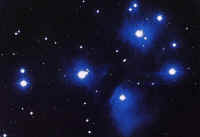M45 (The Pleiades, open cluster in Taurus)
310: The Pleiades (M45) Photograph
M45 is usually called the Pleiades, although it is also known as the Seven Sisters, and the Japanese call it Subaru. Most other cultures throughout history have had their own name for M45. We could talk for hours about the features of the Pleiades, but our purpose tonight is learning how to locate the Winter Messier Objects, so we needn’t spend much time on M45.
At magnitude 1.6, M45 is by far the brightest of all the Messier Objects, and is a naked eye object even from severely light-polluted areas like Winston-Salem. Technically, the Pleiades are part of the constellation Taurus, although many people consider them to be a part of Perseus. The Pleiades are so bright that they are an excellent guidepost themselves, so it seems pointless to specify their location relative to other guideposts, but in the interests of completeness I’ll say that Betelgeuse in Orion and Capella in Auriga form an isosceles triangle with M45, with Betelgeuse forming the apex and M45 and Capella the base.
Given its broad extent, M45 as a whole is best viewed with binoculars, or at most a short tube refractor. Where longer telescopes come into their own with the Pleiades is in viewing smaller parts of the whole, such as the Merope Nebula. For more details about M45, see SEDS or any of the many on-line sites devoted to the Pleiades.
The most interesting issue about the Pleiades is why they’re a Messier Object at all. Messier’s catalog was originally intended to be a list of objects that might easily be confused with comets, and there’s no way that even a novice observer could confuse M45 with a comet. The short answer is that Messier’s original list comprised only 41 objects, and he needed four more objects to round out his list to 45 objects, which would also coincidentally give Messier the lead over a competitor who was also building a similar list. Messier didn’t have much time to come up with four more objects for his list, so he just grabbed four very prominent naked-eye objects—M42 and M43, which are the Great Nebula in Orion, M44, which is the Beehive Cluster, and M45.
